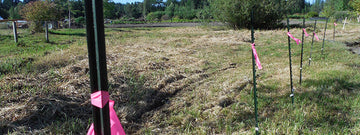Hello again, my friends. This is Farmer Nitai. I’ll be updating you on the very latest news on the farm. A lot has happened in the last week. We finally cleared both banks of the stream, all the land that we intend to plant has been plowed, and a new well has been dug.
What's happening this week?
STREAM RESTORATION
It was a daunting task, but after painstakingly cutting all the tall grasses bordering the stream by hand, we were finally able to see it! Within 10 feet of the stream we strictly used hand tools (a scythe, rakes, and a digging fork) to get the work done, to ensure we did not disturb the stream. We then pulled and raked out all the vegetation that was blocking the flow of the stream. And then it happened - clear, cold water hurriedly flowing across the land, its soft yet relentless sound enchanting us. Just marvelous, I tell ya! There is a heaven, and it's right here, at Uncle Harry's "Farm-acy" :)
After getting the stream to flow without obstructions, our next task was to erect the silt fence twenty-seven (27) feet from edge of the stream, which is important because it keeps loose dirt from entering the stream. Using a bulldozer, we dug up a swath of the thick turf along the outline of our newly delineated stream; and although the weather has been hot and dry, the small ditch quickly filled up with water! It showed me just how much water can be just underground although it seems completely dry! The next step was hammering t-posts into the ground along the edge of our newly created ditch and tying the fence to the t-posts using zip-ties. And voila! Silt fences erected, thus ensuring the water quality of the stream for years to come!






The next step in our stream restoration project is to systematically remove the invasive, non-native grasses that have proliferated in the area and replace them with native ground cover plants, trees to shade the stream, and other beneficial plants. Our vision is to not only restore the stream to its natural state, but to also beautify it, possibly where we could walk its banks and one day see the native fish as they make their way back to their spawning grounds.
PLOWING THE FIELDS
The fields are plowed! It's amazing what machines can do, the work of hundreds of horses or oxen. Our mentor, John (one of the kindest, most easy-going people you'll ever meet) was kind enough to train me how to run the bulldozer. Let me tell you, these machines are powerful! With one flick of the wrist, you can dig a ditch 6 feet deep in the blink of an eye. If you've never dug a ditch by hand and sweated through the hours of hard labor to make one little hole in the ground, then you could not appreciate how much these machines can do! Simply amazing.





The next step is to let the huge pieces of sod rest so as to let them slowly break down into smaller chunks of earth. After that, it will be possible to run the tractor fitted with the disc attachment to further break down the pieces of sod, and start to separate the earth from the vegetation. Soon enough, these fields will be ground to a fine consistency, perfect for planting rows upon rows of sweet, fragrant lavender.
A NEW WELL?
Why do we need a new well, you ask? Well, (no pun intended) our existing well is too shallow and the water is not potable. Also, we will need much more water than the current well can provide to irrigate all of our future crops. I can't wait until we can drink the pure, unadulterated water!






